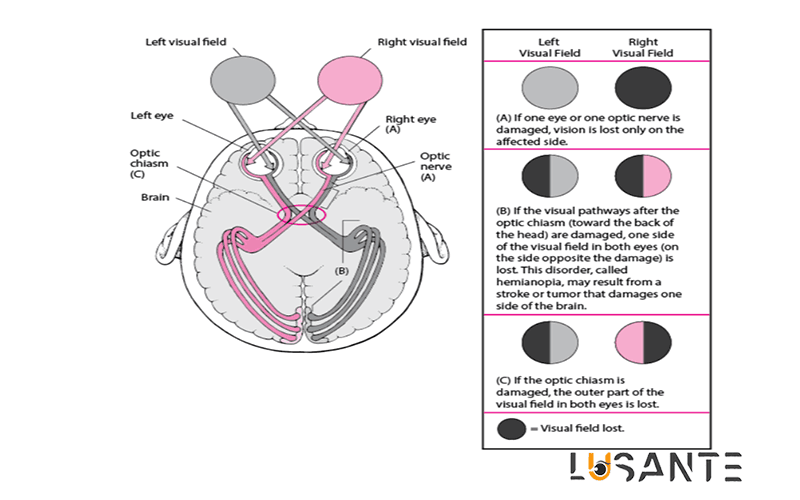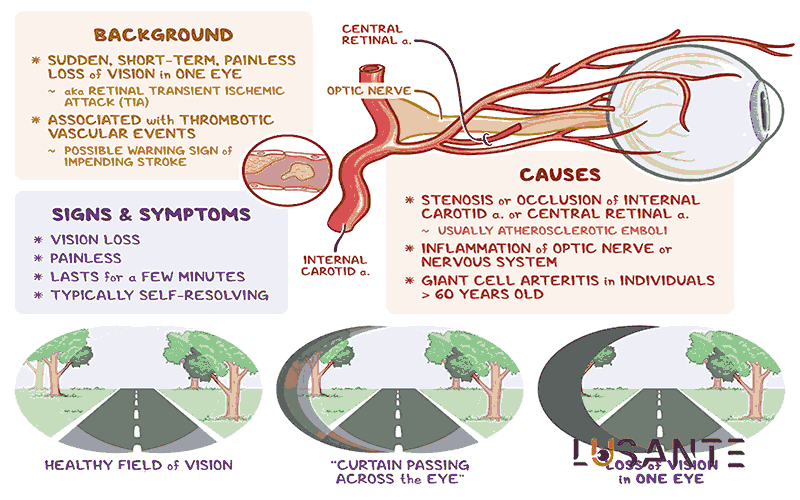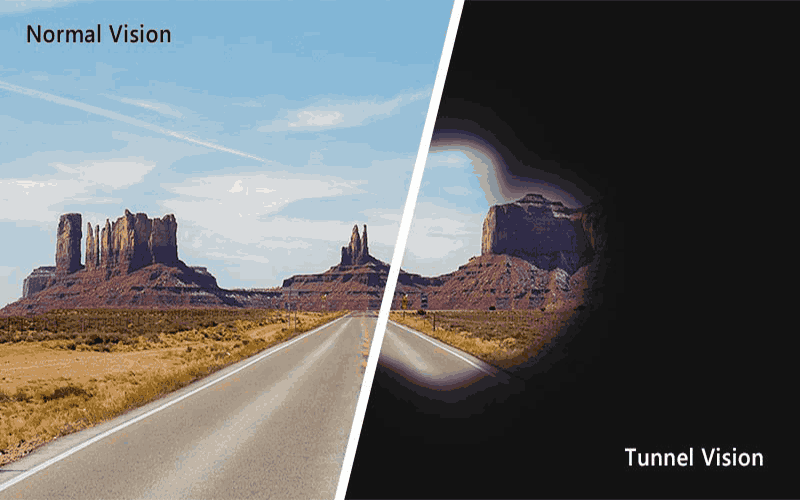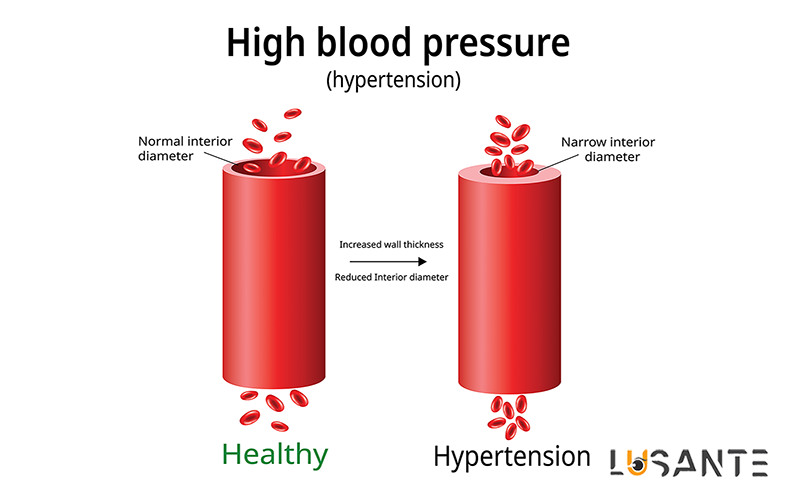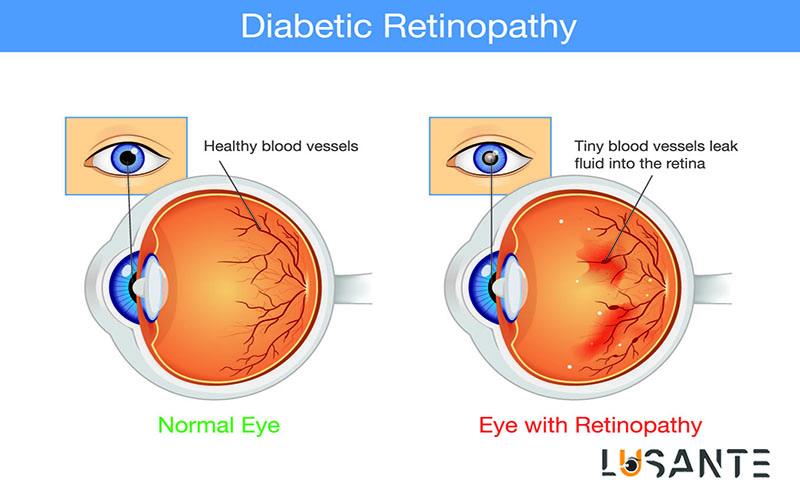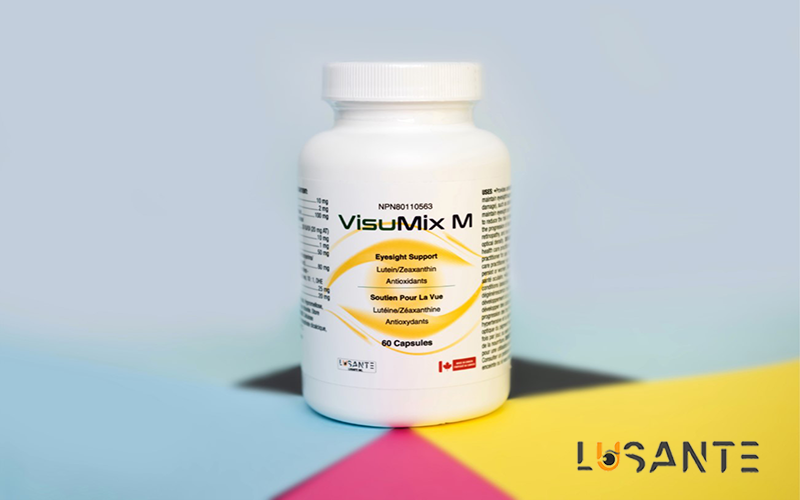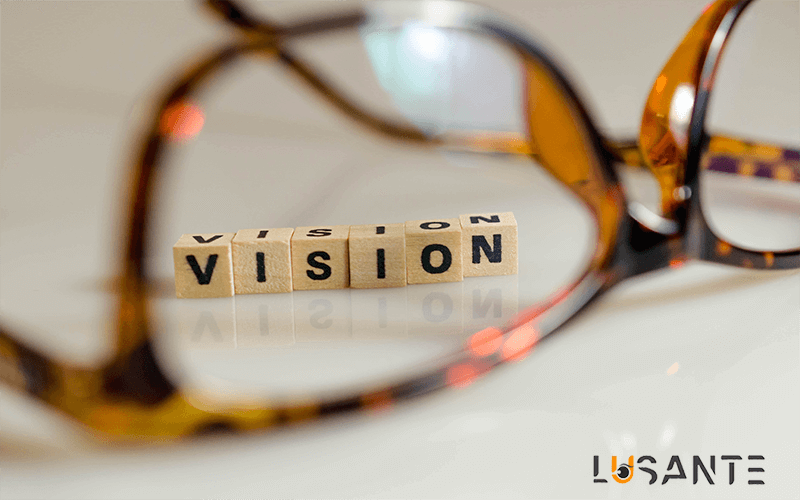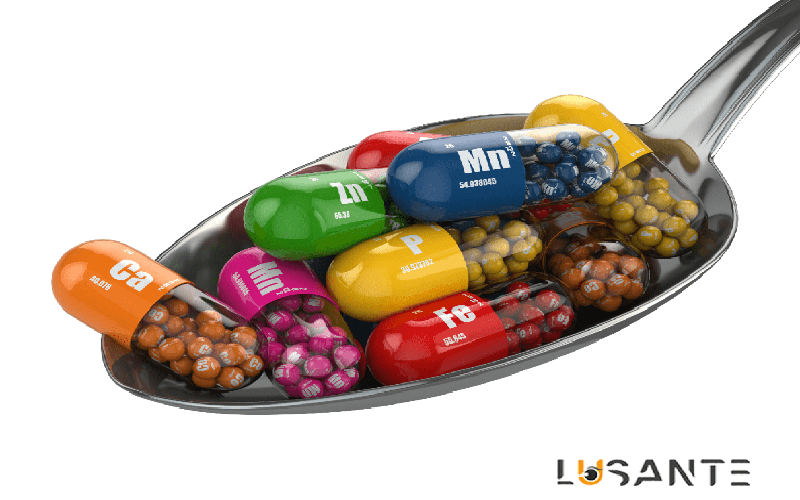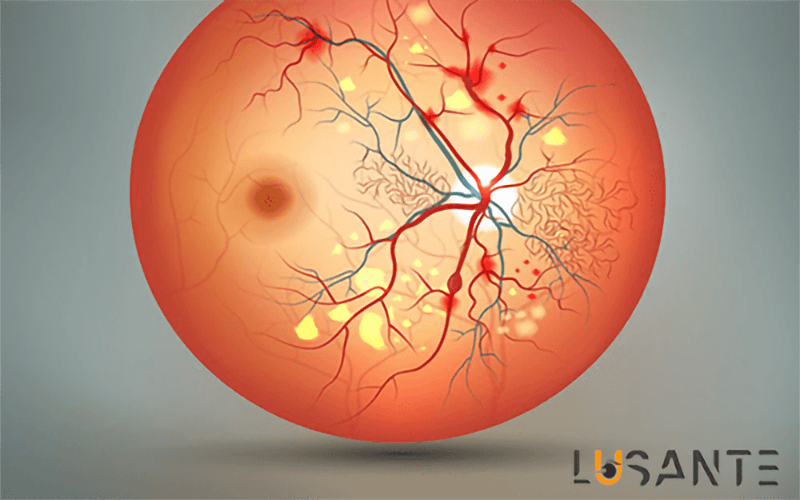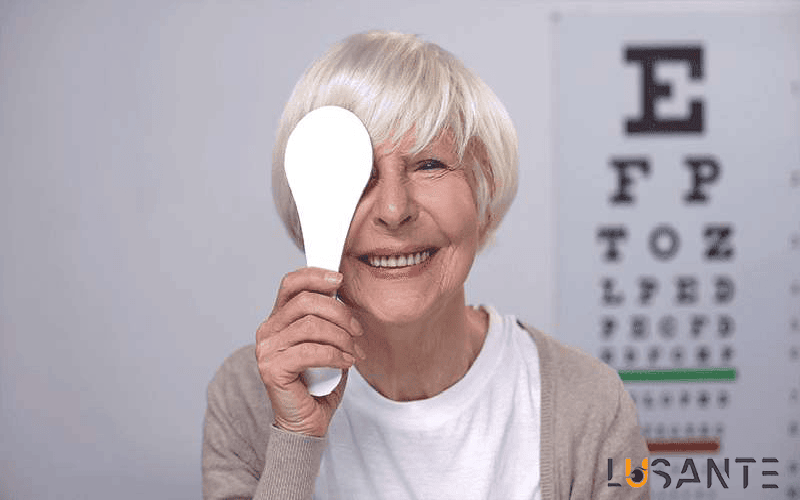8 Amazing ways to Prevent Age Related Macular Degeneration
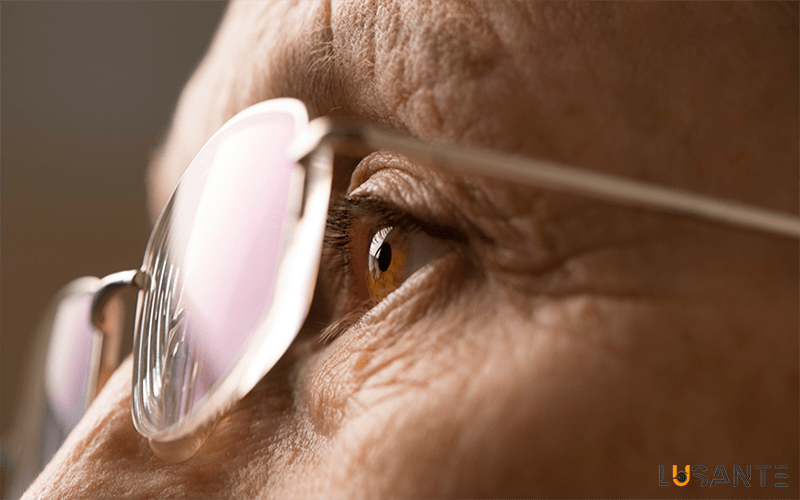
Age Related Macular Degeneration
Prevent Age Related Macular Degeneration; Age-related macular degeneration (ARMD) is a senile degenerative change occurred in the macula (yellow spot) of the elderly. These changes usually took place in the outer retinal layers and could end in low central vision. In fact, ARMD is one of the most important causes of severe visual loss in the elderly; So it is better for everyone to know how to Prevent Age Related Macular Degeneration.
ARMD could be dry (degenerative) or wet (exudative). Wet ARMD is currently managed by intravitreal injection of anti-vascular endothelial growth factors. To date, there is no effective treatment for advanced dry ARMD.
Gene modifications and cell-based therapy showed some promise, but still have a long way to find a safe and effective treatment. Therefore, preventive methods that halt the disease progression are of utmost importance in the context of dry ARMD. Besides sun protection and smoking cessation, oral supplementation with selected minerals and vitamins has shown to decrease the progression of dry ARMD to more advanced stages.
What is yellow spot?
The macula is the most sensitive area of the retina, located at the back of the eye, which is made up of millions of light-sensitive cells and makes vision sharp and precise.
The retina converts light into electrical signals and then sends these inputs to the brain via the optic nerve, which translates these signals into the images we see. When the macula is damaged, the center of the field may appear blurry, irregular, or dark.
Prevent Age Related Macular Degeneration; What factors cause the risk of macular degeneration?
Age is a major risk factor for AMD. The disease is most likely to occur after the age of 60, but it can also occur earlier. Knowing the risk factors of ARMD helps to Prevent Age Related Macular Degeneration.
Other AMD risk factors include:
Smoking: Studies have shown that smoking doubles the risk of AMD.
Race: AMD is more common among Caucasians than African-Americans or Hispanics/Latinos.
Family history and genetics: People with a family history of AMD are at higher risk. According to the latest information, researchers have identified twenty genes that can affect the risk of developing AMD. Many other genetic risk factors are also being investigated.
Since AMD is influenced by many genes as well as environmental factors such as smoking and nutrition, currently there is no genetic test to diagnose or predict AMD occurrence. However, there are many ways to Prevent Age Related Macular Degeneration.
The American Academy of Ophthalmology does not suggest genetic testing to diagnose AMD since there is no gene therapy for the prevention and treatment of this disease.
Prevent Age Related Macular Degeneration; Does lifestyle have an effect on the disease?
Researchers have found a relationship between AMD and some of our daily habits, such as smoking.
You can reduce the risk of developing AMD or slow down its progression by taking the following steps:
- Quit Smoking
- regular exercise
- Maintaining blood pressure and blood cholesterol levels in a normal range
- A healthy diet containing green leafy vegetables and fish
Prevent Age Related Macular Degeneration; How is macular degeneration diagnosed?
Early and middle stages of AMD are usually asymptomatic.
Only a comprehensive dilated eye exam can diagnose AMD. An eye examination can include the following:
Visual acuity test: This eye chart measures the ability to see at a distance.
Dilated eye examination: the ophthalmologist puts a drop into the eye that causes pupils dilation, which allows doctors to see behind the patient’s eye better, then the ophthalmologist uses special magnifying lenses (magnifying glasses) and examines the retina and optic nerve for signs of AMD and other eye problems,
Amsler grid: Your eye doctor may ask you to look at the Amsler grid. Changes in central vision can lead to disappearing or wavy grid lines, which is a symptom of AMD.
Fluorescent angiogram: In this test, which is performed by an ophthalmologist, a fluorescent dye is injected into the arm and a picture is taken when the dye passes through the blood vessels of the eye, which leads to the identification of leakage from the vessels. This is a sign of severe and rapidly progressive types of macular degeneration.
In rare cases, dye injection can cause side effects such as nausea to severe allergic reactions.
Prevent Age Related Macular Degeneration; Types of macular degeneration
There are two types of macular degeneration:
- dry
- wet
The dry form of this disease is common, but the wet form occurs faster and is more severe.
Symptoms of dry macular degeneration include:
- Distortion of straight lines in the field of vision
- Decreased central vision
- Need more light to see
- Incompatibility with low light
- blurred vision
- Difficulty recognizing faces
Symptoms of wet macular degeneration are:
- crooked nose
- Decreased central vision
- Seeing a dark spot in the field of vision
- blurred vision
How To Prevent Age Related Macular Degeneration?
- regular exercise
The benefits of exercise for the body are countless. Exercise may reduce the risk of developing AMD. If you do not exercise, fatty plaque deposits occur in the macular vessels. This deposit can disrupt blood flow and increase the risk of AMD; So it is hard to Prevent Age Related Macular Degeneration.
A study published in 2006 in the British Journal of Ophthalmology showed the protective effect of physical activity against AMD independent of body mass index and other factors.
Another study published in 2016 in the same journal reported that vigorous physical activity may reverse the presence of moderate AMD in women.
A 2017 study published in the American Journal of Ophthalmology also found that physical activity was associated with a reduced risk of early AMD in whites. Researchers emphasized the importance of physical activity throughout life. However, the researchers noted that more studies should be conducted to confirm whether physical activity and exercise have a protective effect against AMD.

- Quit Smoking
If you are a smoker, it is time to quit to Prevent Age Related Macular Degeneration. Smoking is one of the factors that increase the risk of macular diabetes. In fact, smoking is the most important modifiable risk factor for the development and progression of AMD.
Cigarette smoke contains toxic chemicals that are absorbed into the body through the lungs. Some of these chemicals are oxidants that can damage the retina when they pass through the bloodstream.
A 2005 study published in Eye confirmed a strong link between smoking and the development of AMD. It can be explained that smoking probably increases the toxic effects on the retina.
A study published in the Journal of Ophthalmology in 2013 reported that smoking may damage chorioretinal tissues. This study advises patients to quit smoking
To quit smoking, get help from family and friends, and experts in this field.

- Quit alcohol
Although smoking is the most known risk factor for developing AMD, drinking excessive amounts of alcohol is also bad for eyesight. Alcohol is a poisonous substance and easily burns the optic nerve.
For this reason, during the early stages of poisoning, blurred vision occurs. But over time, this toxicity can cause long-term problems such as early-onset AMD. In addition, the toxins in alcohol, when entering the bloodstream, reduce the delivery of nutrients to the nerves and macula.
A 2007 study published in the American Journal of Ophthalmology indicated that alcohol consumption is unlikely to significantly increase the risk of AMD.
A study published in 2012 in the American Journal of Epidemiology showed that consuming more than 20 grams (less than 1 ounce) of alcohol per day was associated with an almost 20% increased chance of developing AMD compared to those who did not. They do not drink alcohol.
So, if you can’t give up alcohol, at least cut down on it.
- Protect eyes from UV rays
It is a fact that exposure to ultraviolet (UV) light from the sun can cause skin damage, but this factor can even increase the risk of macular degeneration and other eye diseases.
Staring at sunlight for even a few minutes can cause permanent damage to the retina. That’s why experts recommend wearing sunglasses and hats to protect your eyes from the sun. sunglasses also help to Prevent Age Related Macular Degeneration.
A 2011 study published in Eye & Contact Lens found that UV radiation is a risk factor for cataract formation and macular degeneration. The study also found that people over 50 should wear specially designed glasses or contact lenses to prevent age-related macular degeneration.
Therefore, do not look directly into the sunlight, especially during peak sunlight hours, when the sun’s rays are at their strongest. Also, if you work a lot or use a lot of electronic devices, it is important to look away every 20 minutes to reduce eye pressure.
- Blood pressure control
High blood pressure is one of the risk factors for developing wet AMD. High blood pressure can lead to constriction or narrowing of the blood vessels that feed the retina. This means that less nutrients grow into the eye. Lack of these nutrients will have a negative effect on eye health.
A 2000 study published in Ophthalmology looked at several risk factors associated with AMD and found that preventing high blood pressure may reduce the risk of developing AMD.
Another study published in Ophthalmology in 2014 found a link between the use of blood pressure-lowering medications, including blood vessel dilators, and the development of early-stage AMD.
Therefore, maintaining balanced blood pressure levels becomes crucial in limiting the risk of macular degeneration. By actively managing blood pressure, individuals can help prevent age related macular degeneration and safeguard their vision for the long term.

- Eating healthy food
Following a healthy diet is very important to reduce the risk and prevent macular degeneration. First of all, there should be plenty of dark, leafy vegetables in your diet, especially raw spinach, kale, and other greens. This will help you get the carotenoids (lutein and zeaxanthin) that are important for overall eye health.
Also, consuming a lot of fruits and nuts provides essential vitamins such as A, C and E.
Eating fish such as salmon, tuna and sardines regularly can Prevent Age Related Macular Degeneration. These fish are a good source of omega-3 fatty acids that help reduce inflammation in the body.
If needed, you can use vitamins and minerals in supplement form, but always consult your doctor before taking these supplements.

- Consuming less refined carbohydrates
When focusing on a healthy diet to reduce your risk of developing AMD, you should limit your intake of refined carbohydrates such as white bread, white rice, and processed and baked foods with added sugar.
Based on the results of a study published in 2004 in the American Journal of Clinical Nutrition, it was found that refined carbohydrates can significantly increase the risk of developing macular diabetes.
Refined carbohydrates should be replaced with low-glycemic index foods, including brown rice, whole-wheat pasta, and whole-wheat bread. Foods with a low glycemic index have many antioxidants.
By adopting a diet focused on low-glycemic index foods and reducing the consumption of refined carbohydrates, you can help prevent age related macular degeneration and promote overall eye health.

- Regular examination
To find the first signs of macular degeneration and early diagnosis of this disease, you should see an eye doctor regularly. Always remember that early diagnosis and treatment may help control the progression of the disease and even stabilize or even restore vision.
It is very important to have an eye exam once a year between the ages of 45 and 60. But if you have risk factors associated with AMD, it’s best to get your eyes checked every six months to Prevent Age Related Macular Degeneration.
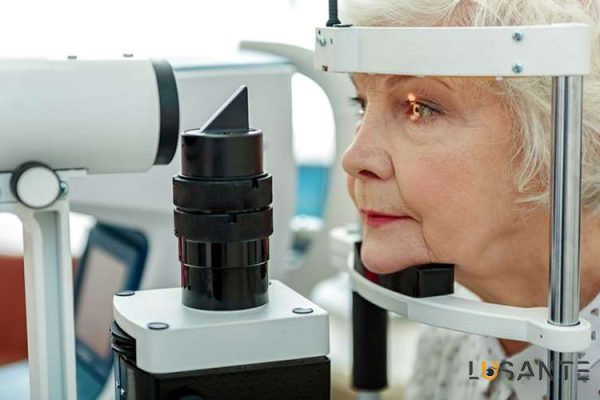
What vitamins are suitable toPrevent Age Related Macular Degeneration?
Having a healthy and principled lifestyle and following a healthy diet are factors that can have a significant impact on eye health and vision enhancement. Although vitamins and nutritional supplements do not cure eye diseases, they can be of some help to prevent age related macular degeneration.To know more complete information about the introduction of vitamins that can be suitable to prevent age related macular degeneration, stay with us until the end of the content.
Vitamin E
The most important antioxidant in the human body is vitamin E. This vitamin protects the cells of the body and keeps them healthy. If the absorption of vitamin E is high along with vitamins A and C; The probability of cataract disease is greatly reduced in old age.
Vitamin E, like vitamin lutein, protects the eyes against free radicals. It is better to prescribe vitamin E under the supervision of a specialist doctor. In fact, vitamin E is in the category of fat-soluble vitamins, and consuming too much of it may be harmful to the body. They do not affect the eye, but they can help to prevent age related macular degeneration.
To know more complete information about the introduction of vitamins that can be suitable to prevent age related macular degeneration, stay with us until the end of the content.

Zinc
Zinc is one of the metals that does not directly affect the health of the eyes. But this metal can cause the production of melanin or protect the eye pigment by delivering vitamin A from the liver to the retina. Zinc is not produced alone in the body. Therefore, those who want to guarantee the health of their eyes or even Prevent Age Related Macular Degeneration, It is better to use materials that contain zinc metal in their diet.
Vitamin A
Vitamin A can benefit the eyes in two ways. Retinol and carotenoid are antioxidant compounds that can protect the eyes from harmful factors. Retinol is usually found in animal foods, but carotenoids such as beta-carotene are also found in vegetables such as carrots.
Vitamin A helps the mucous membrane of the eye to resist the entry of various viruses and bacteria into the eye. This is why the consumption of vitamin A greatly reduces the possibility of eye infections, help to Prevent Age Related Macular Degeneration and strengthens the eyesight.

Vitamin C
All cells in the body need vitamin C to maintain their health and function better. Gums, cartilage, veins, teeth, etc., are some of the places that function properly if you receive vitamin C. This vitamin can cause proper blood flow to the eyes. Vitamin C can help the body deliver nutrients to the eyes. Therefore, consuming as much as this antioxidant can prevent eye fatigue and prevent Age Related Macular Degeneration and the occurrence of many diseases such as cataracts.
Vitamin B6 and B12
Vitamin B6 and B12 are other vitamins that can reduce the risk of ARMD and Prevent Age Related Macular Degeneration. These two vitamins, along with vitamin B9, reduce homocysteine in the blood.
Homocysteine is one of the substances that cause damage to blood vessels. Those who want to naturally reduce the risk of age-related macular degeneration should be able to get a variety of vitamins b6, b12 and b9 in their daily schedule.

AREDS 2 Supplement to Prevent Age Related Macular Degeneration (AMD)
Age-related macular degeneration (AMD) is an eye disease that can blur the center of your vision. If you have intermediate AMD in one or both eyes, special nutritional supplements called AREDS 2 can help slow the rate of vision loss.
-
Prevent Age Related Macular Degeneration; Are AREDS 2 supplements suitable for me?
It depends on your AMD stage. If you have AMD in one or both eyes, these supplements may be able to Prevent Age Related Macular Degeneration from turning into late AMD.
AREDS 2 supplements cannot prevent the conversion of early (onset) AMD to intermediate AMD. If your eye doctor tells you that you have early AMD, have a dilated eye exam at least once a year so your doctor can track any changes.
If you only have late AMD in one eye, AREDS 2 may slow the progression of AMD in the other eye. If you have late AMD in both eyes, AREDS 2 supplements probably won’t help. If you have wet AMD (a type of late AMD), you may have other treatment options
-
Prevent Age Related Macular Degeneration; Do these supplements have any risks or side effects?
Because AREDS 2 supplements contain very high amounts of vitamins and minerals, they may change the way you digest food and the way other medications work in your body.
An older version of these supplements—called AREDS instead of AREDS 2—contains beta-carotene, which can increase the risk of lung cancer in people who smoke or have smoked. AREDS 2 supplements do not contain beta-carotene. So if you smoke or used to smoke, be sure to choose the newer AREDS 2 supplements.
You can order VisuMix M which contains all ingredients of AREDS II formula on Amazon.
Always talk to your doctor before starting a new medication or supplement and let him know about other medications, vitamins, and supplements you are taking. Your doctor can help you understand the risks and benefits of taking AREDS 2.
-
Prevent Age Related Macular Degeneration; The ingredients of these supplements
AREDS 2 supplements are made with high amounts of specific vitamins and minerals.
Amount of material in AREDS 2
- Vitamin C is equal to 500 mg
- Vitamin E is equal to 400 international units (IU).
- Copper (copper oxide) 2 mg
- Zinc (Zinc) 80 mg
- beta carotene
- Lutein 10 mg
- Zeaxanthin 2 mg
You cannot get the right combination of these vitamins and minerals from food or regular multivitamins. Only AREDS 2 supplements have the right ingredients and amounts to help reduce vision loss from AMD.
-
Prevent Age Related Macular Degeneration; Where can I get AREDS 2 supplements?
AREDS 2 supplements can be purchased at many pharmacies or online.
Visumix M supplement, by using very useful compounds, has a high effect in controlling and preventing age-related macular degeneration. When choosing a supplement, check the ingredient list to make sure it contains all the vitamins and minerals in the exact amounts listed above.
Ralated Product: Visumix M
Treatments for wet macular degeneration (Advanced Neovascular AMD)
Age-related macular degeneration (AMD) is an eye disease that can blur the center of your vision. Wet AMD (also called advanced neovascular AMD) is a serious type of late AMD. This disease occurs when a protein called vascular endothelial growth factor or VEGF causes abnormal blood vessels to grow in an inappropriate place behind the eye.
The good news is that there are effective treatments for wet AMD. There are two treatment options that can slow or stop vision loss from wet AMD:
- Anti-VEGF injection
- photodynamic therapy (PDT)
If you have vision loss from wet AMD, ask your eye doctor if any of these treatments can help you.
If you have moderate (intermediate) AMD in one or both eyes, certain nutritional supplements (vitamins and minerals) can help prevent it from turning into late AMD.
What is anti-VEGF injection?
The most common treatment doctors use to slow vision loss from wet AMD is called an anti-VEGF injection. These medications help stop bleeding and leaky blood vessels behind your eyes. Most people with wet AMD receive anti-VEGF injections as their only treatment.
In this treatment, the doctor does the following:
- Puts numbing medicine in your eye
- It cleans your eye so it doesn’t get infected
- He injects anti-VEGF medicine into your eye with a very small needle
Anti-VEGF injections usually only work for a short time, so most people will need to have multiple injections. At first, most people need injections once a month. After that, the doctor will tell you how often you need the injection.
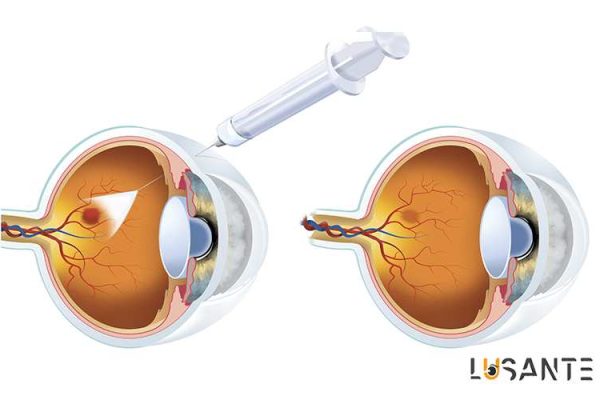
What is photodynamic therapy (PDT)?
Photodynamic therapy (PDT) is a less common treatment for wet AMD that doctors sometimes use along with anti-VEGF injections.
PDT works by using a light-sensitive drug called verteporfin, which is “triggered” when exposed to a certain type of laser (sometimes called a cold laser). Your doctor will shine a laser into a very small area at the back of your eye, causing the verteporin to break up the blood vessels that are causing your vision loss.
During this treatment, the doctor does the following:
- He injects a shot of vertporfin into your arm
- Puts numbing medicine in your eye
- A special contact lens will be placed over your eye to help guide the laser
- It shines a laser on the extra blood vessels in the back of your eye
Some people need to receive PDT more than once. Talk to your doctor to find out if you need more treatments to help stop vision loss from AMD.
Prevent Age Related Macular Degeneration; What is optical coherence tomography (OCT)?
You’ve probably heard about ultrasound, which uses sound waves to image living tissue. OCT is similar to ultrasound with the difference that it uses light waves instead of sound waves and can produce high-quality images of any tissue that light penetrates, including the eye.
After the eyes widen, you will be asked to place your chin in the resting position and keep the head still for a few seconds until the picture is taken. The ray of light is painless.
During the eye exam, the eye doctor will look for drusen, which are yellow deposits under the retina. In most people, during the natural aging process, small drusen are formed in the eye. The presence of medium to large drusen can indicate AMD.
To Prevent Age Related Macular Degeneration, notice that another symptom of AMD is the presence of subretinal pigmentary changes. In addition to pigmented cells in the iris (the colored part of the eye), there are also subretinal pigmented cells. If these cells break and release the pigments inside them, the ophthalmologist may see dark masses from the released pigments and later paler areas. These changes do not affect eye color.
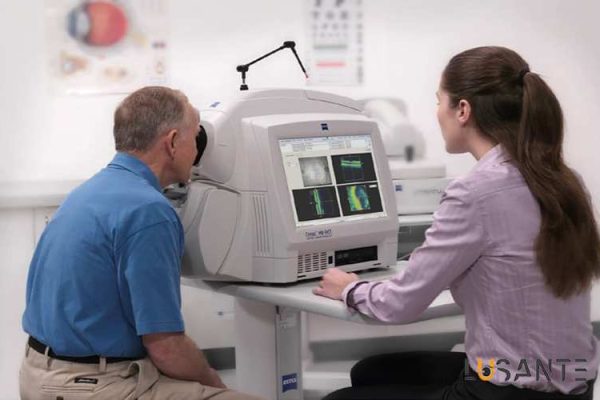
What questions should you ask your eye doctor?
Below is a list of questions that you can ask your doctor to better understand your illness and treatment. If you do not understand the doctor’s answers, continue asking your questions until you get the correct understanding.
- What is the name of my disease and how is it written?
- Is macular degeneration curable?
- How will this disease affect my vision now and in the future?
- What symptoms should I watch out for and how should I notify you if they occur?
- Should I make a change in my lifestyle?
Prevent Age Related Macular Degeneration; What are the stages of macular degeneration?
We should know AMD stages to Prevent Age Related Macular Degeneration. AMD has 3 stages, which are defined according to the size and number of subretinal drusen. It is possible that a person’s AMD is only in one eye or that the stage of AMD in one eye is different from the other eye.
- Early: Early AMD is diagnosed by the presence of medium-sized drusen with a diameter about the diameter of an average human hair.
- Intermediate: People with intermediate AMD usually have large drusen or retinal pigment changes, or both. These changes are only detected during an eye exam. Intermediate AMD can sometimes lead to vision loss, but most people have no symptoms
- Terminal: In addition to having drusen, people with terminal AMD also lose vision due to macular damage. There are 2 types of final AMD:
In the type of geographic atrophy (also called dry AMD), over time, the light-sensitive cells of the macula, which direct visual information to the brain, and the supporting tissue under the macula are destroyed. These changes lead to vision loss.
In neovascular AMD (also called wet AMD), abnormal blood vessels grow under the retina (neovascular means new vessel). Fluid and blood leak from these vessels, which can lead to swelling and damage to the macula.
Unlike geographic atrophy, which develops over time, in neovascular the damage can be rapid and severe. It is possible to have both geographic atrophy and neovascular AMD in the same eye, either of which can occur first.
AMD also has a series of symptoms in the early stages, so regular eye examinations and examinations are important. If you are at risk of developing AMD due to various reasons such as age, family history, lifestyle or a combination of these things, examination and Do not delay the examination until vision changes appear.
Not all people with early AMD develop the late type. 5% of people who have early AMD in one eye and the other eye is healthy will develop advanced AMD in the next 10 years.
About 14% of people with early AMD in both eyes will develop late AMD in at least one eye after 10 years. There are a number of measures that can be taken to reduce the chance of vision loss in late AMD.
If you have end-stage AMD in one eye, you may not notice a change in your overall vision, but you may still be able to drive, read, and see fine details because of the clear vision in the other eye. However, terminal AMD in one eye means an increased risk of developing terminal AMD in the other eye. Consult a doctor.

Prevent Age Related Macular Degeneration; How is macular degeneration treated?
- Early AMD
There is currently no cure for early AMD, which in most people is asymptomatic and without vision loss. Your eye doctor will likely recommend that you have a dilated eye exam at least once a year. This examination helps to determine whether the disease is progressing or not.
- Intermediate and final AMD
Researchers at the Eye Health Organization examined the effect of dietary supplements in protecting against AMD in the Age-Related Eye Diseases Study (AREDS) and (AREDS2).
They concluded that high-dose vitamins and minerals can To slow the progression of the disease in people with intermediate AMD and people with terminal AMD in one eye.
The first AREDS trial showed that a combination of vitamin C, vitamin E, beta-carotene, zinc and copper can reduce the risk of late AMD by 25%. AREDS2 test investigated the effect of adding lutein and zeaxanthin and omega-3 fatty acids to the above formula.
Omega-3 fatty acids are abundantly found in fish oil. Lutein, zeaxanthin and beta-carotene all belong to the same family of vitamins and are abundant in green leafy vegetables.
The AREDS2 trial found that adding lutein, zeaxanthin, or omega-3 to the original formula that contained beta-carotene had little effect on the risk of eventual AMD.
However, the trial also showed that replacing beta-carotene with 5-to-1 lutein and zeaxanthin could further reduce the risk of late AMD.
In addition, while beta-carotene is associated with an increased risk of lung cancer in smokers and quitters, lutein and zeaxanthin are safe regardless of being a smoker or not.
The list of compounds used in AREDS and AREDS2 includes the following:
- 500 mg of vitamin c
- 400 international units of vitamin e
- 80 mg of zinc in the form of zinc oxide
- 2 mg of copper in the form of copper oxide
- 10 mg of lutein and 2 mg of zeaxanthin
If you have intermediate or end-stage AMD, it may be useful to take these compounds, but first, read and compare the labels of the supplements. Most of the supplements have different ingredients and dosage than the ingredients and dosage tested in AREDS tests.
Also consult your doctor or ophthalmologist about the choice of supplement. For example, if you are a current or former smoker, your doctor may suggest that you avoid taking beta-carotene supplements.
If you are at risk for terminal AMD, you should consider using AREDS supplements even if you take a daily multivitamin. The formulas reviewed in AREDS have much higher doses of vitamins and minerals compared to multivitamins.
Inform your doctor about taking any multivitamins when discussing possible AREDS formula choices. You may see claims that a person’s specific genetic makeup can affect how they respond to AREDS supplements, some recent studies have claimed that depending on genetics, AREDS supplements can be beneficial for some people and harmful for others.
Based on a part of AREDS research data, NEI researchers have comprehensively reviewed and analyzed all AREDS data. Based on the overall data, the American Academy of Ophthalmology opposes genetic testing to guide the treatment of AMD.
Finally, remember that the AREDS formula is not a definitive cure. This formula has no effect on people with early AMD and does not bring back lost vision, but it can delay the onset of AMD or slow down the rate of vision loss in people with late AMD.
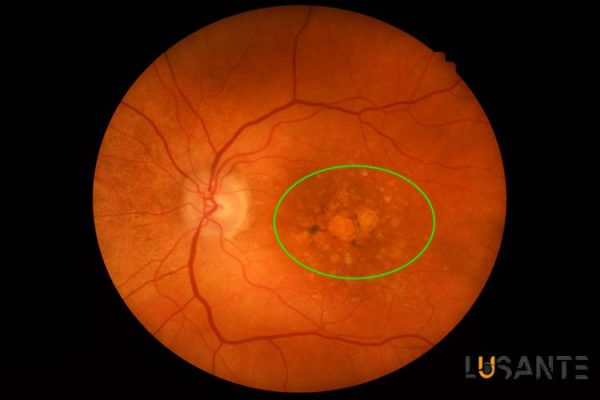
- Advanced neovascularization
Neovascular AMD usually results in severe vision loss. However, eye doctors can use various treatments to stop further vision loss. You should keep in mind that the methods listed below do not cure and completely eliminate the disease, and the disease may progress even with the use of different treatment methods.
Injections: One of the options to slow down the progression of neovascular AMD is injecting medicine into the eye. In neovascular AMD, a high concentration of vascular endothelial growth factor (VEGF) is secreted into the eye.
VEGF is a protein that stimulates the growth of new and abnormal blood vessels. Anti-VEGF injection inhibits the growth. If you receive this treatment, you may need multiple monthly injections. You may be prescribed antibiotic drops to reduce the risk of infections.
There are several different anti-VEGF drugs that differ in terms of price and injection frequency, so it is better to consult with your eye doctor when choosing a drug.
Photodynamic therapy: This technique includes laser treatment of certain areas of the retina. First, a drug called vertoprofin is injected into the arm.
This drug is transported through the body’s blood vessels and absorbed by the new, growing blood vessels, then the ophthalmologist uses laser light to activate the drug in the abnormal new blood vessels, while the normal blood vessels remain intact.
After activation, it closes the new blood vessels, slows down their growth and slows down the rate of vision loss. This method is used less often than anti-VEGF injections and is usually used in combination with anti-VEGF in certain types of neovascular AMD.
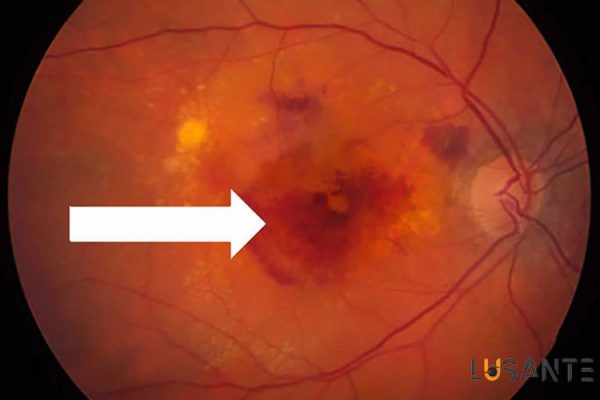
- Laser surgery
Ophthalmologists treat certain types of AMD with laser surgery, but this method is used less often than other treatments. This treatment involves shining a strong “hot” laser on the abnormal blood vessels in the eye to destroy them.
This laser is not the same as the laser used in photodynamic therapy, which is called a “cold” laser. This treatment is usually used when the growth and blood vessels are limited to a contiguous area far from the center of the macula that can be easily targeted by the laser.
However, laser treatment can also destroy the surrounding healthy tissue, leading to It is used to create blind spots in the damaged areas of the retina by laser.
In some cases, the vision may be weaker and worse immediately after the operation than before the operation, but the surgery can help prevent severe loss of vision in the coming years.
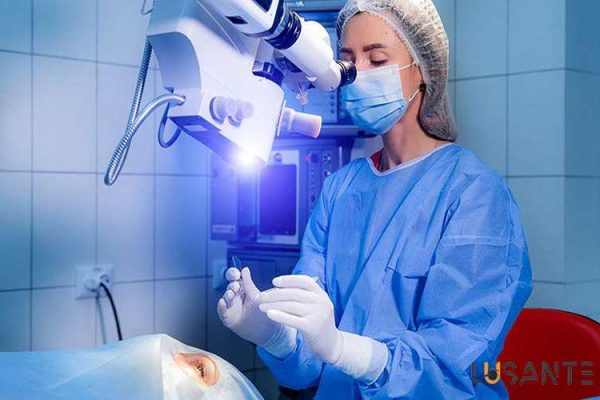
Questions to ask your eye doctor about treatment:
- What is the treatment for advanced neovascular AMD?
- When did the treatment start and how long does it take?
- What are the benefits of this treatment and how successful is it?
- What are the risks and side effects of this treatment and how was this information collected?
- Should I avoid certain foods, medicines and activities during the treatment?
- Are there other treatments available?
- After the treatment, when should I visit for follow-up?
Prevent Age Related Macular Degeneration; Compromise with macular degeneration?
Macular degeneration and vision loss can have a significant impact on your life, especially if vision loss occurs quickly.
Even if you lose your vision over time, you may not be able to live your life as before. You may have to leave your job, volunteer and charity work, and recreational activities. Your relationships may change and you may need the help of friends and family more than before.
These changes can lead to feelings of loss, low self-confidence, isolation and depression. In addition to drug treatments, you can use the following measures to cope with macular degeneration:
- Learn more about your vision loss.
- See a low vision specialist and use the devices and skills you learn to help you do everyday tasks.
- Be positive. Hopeful people are said to be better able to cope with macular degeneration and vision loss.
- Stay in touch with your friends and family.
- Seek a professional counselor or support group. Your doctor or ophthalmologist can refer you to counselors or support groups.
Information for family members
Shock, disbelief, depression and anger are common reactions in people with AMD. These feelings can disappear after days to weeks or remain for a longer period of time, and this can be disturbing for family members or guardians who are trying to be as supportive, compassionate and considerate as possible.
The following ideas can be helpful for family members:
- Gather as much information as possible about macular degeneration and how it affects vision.
- Look for support groups and other resources in the community.
- Encourage friends and acquaintances to visit and support the person with macular degeneration.
- Allow yourself to grieve, because it is a natural process.
- Show your support by being available.
Prevent Age Related Macular Degeneration; What research is being done??
NEI conducts or supports research in laboratories and clinics across the country to prevent, diagnose and treat AMD.
NEI-funded research over the past decade has led to new insights into the genetics of AMD. By screening thousands of genes in people with AMD and healthy controls, scientists have found differences in genes that increase the risk of developing AMD.
With this knowledge, researchers are identifying the biochemical pathways involved in the disease and testing treatments. which can stop these pathways. It is also possible to make AMD drugs according to the unique genetic risk factors of people.
Scientists are also looking for ways to regenerate the tissue destroyed by macular degeneration, one of these methods is to create stem cells from the patient’s skin and blood. These cells can grow into sheets of retinal pigment epithelium (PRE) in the laboratory. – Create the pigmented tissue layer that supports the light-sensitive cells in the retina.
The purpose of this work is to form layers of PRE that can be implanted in the patient’s eye to preserve vision. NEI’s ambitious goals organization (AGI) is tackling one of medicine’s greatest challenges: regenerating neurons in the brain and network.
In humans, the loss of nerve cells in the brain and retina (for reasons such as injury or diseases such as AMD) is usually irreversible and permanent. However, the lessons of nature indicate that overcoming this limitation can be possible.
For example, in some fish and amphibians, the retina can be repaired after damage. Using focused research, NEI AGI aims to achieve these secrets and apply them in humans in order to invent new therapeutic methods for the regeneration of neurons, nerve cells and neural connections in the eye and visual system.







